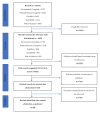A Scoping Review of Capacity-Building Efforts to Address Environmental Justice Concerns
- PMID: 32466474
- PMCID: PMC7312702
- DOI: 10.3390/ijerph17113765
A Scoping Review of Capacity-Building Efforts to Address Environmental Justice Concerns
Abstract
Environmental justice (EJ) efforts aimed at capacity building are essential to addressing environmental health disparities; however, limited attention has been given to describing these efforts. This study reports findings from a scoping review of community-academic partnerships and community-led efforts to address environmental inequities related to air, water, and land pollution in the United States. Literature published in peer-reviewed journals from January 1986 through March 2018 were included, and community capacity theory was applied as a framework for understanding the scope of capacity-building and community change strategies to address EJ concerns. Paired teams of independent analysts conducted a search for relevant articles (n = 8452 citations identified), filtered records for content abstraction and possible inclusion (n = 163) and characterized selected studies (n = 58). Most articles implemented activities that were aligned with community capacity dimensions of citizen participation (96.4%, n = 53), community power (78%, n = 45), leadership (78%, n = 45), and networks (81%, n = 47); few articles identified a direct policy change (22%, n = 13), and many articles discussed the policy implications of findings for future work (62%, n = 36). This review synthesizes three decades of efforts to reduce environmental inequities and identifies strategic approaches used for strengthening community capacity.
Keywords: advocacy; community capacity; community organizing; environmental justice; mobilization; social justice.
Conflict of interest statement
The authors declare no conflict of interest. The funders had no role in the design of the study; in the collection, analyses, or interpretation of data; in the writing of the manuscript, or in the decision to publish the results.
Figures
Similar articles
-
From Roots to Results: A Qualitative Case Study of the Evolution of a Public Health Leadership Institute Building Capacity in Collaborating for Equity and Justice.Health Educ Behav. 2019 Oct;46(1_suppl):33S-43S. doi: 10.1177/1090198119853616. Health Educ Behav. 2019. PMID: 31549561
-
Community-driven research and capacity building to address environmental justice concerns with industrial air pollution in Curtis Bay, South Baltimore.Front Epidemiol. 2023;3:1198321. doi: 10.3389/fepid.2023.1198321. Epub 2023 Sep 12. Front Epidemiol. 2023. PMID: 38099060 Free PMC article.
-
Nursing strategies for environmental justice: A scoping review.Public Health Nurs. 2021 Mar;38(2):296-308. doi: 10.1111/phn.12840. Epub 2020 Nov 19. Public Health Nurs. 2021. PMID: 33210747
-
Beyond the black stump: rapid reviews of health research issues affecting regional, rural and remote Australia.Med J Aust. 2020 Dec;213 Suppl 11:S3-S32.e1. doi: 10.5694/mja2.50881. Med J Aust. 2020. PMID: 33314144
-
Methods in Public Health Environmental Justice Research: a Scoping Review from 2018 to 2021.Curr Environ Health Rep. 2023 Sep;10(3):312-336. doi: 10.1007/s40572-023-00406-7. Epub 2023 Aug 15. Curr Environ Health Rep. 2023. PMID: 37581863 Free PMC article.
Cited by
-
Environmental health risk relationships, responsibility, and sources of information among Vietnamese Americans in coastal Mississippi.Health Risk Soc. 2020;22(5-6):362-376. doi: 10.1080/13698575.2020.1840528. Epub 2020 Oct 27. Health Risk Soc. 2020. PMID: 33762882 Free PMC article.
-
Waves of change: A systematic literature review of water and environmental justice research.Hydrol Sci J. 2023 Dec 5;69(1):120-138. doi: 10.1080/02626667.2023.2280679. Hydrol Sci J. 2023. PMID: 39996026 Free PMC article.
-
Grassroots mobilization for a just, green urban future: Building community infrastructure against green gentrification and displacement.J Urban Aff. 2023 Apr 5;47(2):347-380. doi: 10.1080/07352166.2023.2180381. eCollection 2025. J Urban Aff. 2023. PMID: 39906343 Free PMC article.
References
-
- Bullard R.D., Mohai P., Saha R., Wright B. Toxic Wastes and Race at Twenty, 1987–2007: A Report Prepared for the United Church of Christ Justice & Witness Ministries. United Church of Christ; Cleveland, OH, USA: 2007.
-
- Bernier C.J. Almost Everything You Need to Know about Environmental Justice. [(accessed on 1 March 2020)]; Available online: http://www.ucc.org/justice_advocacy_resources_pdfs_environmental-justice....
-
- Prüss-Üstün A., Corvalán C. Preventing Disease through Healthy Environments: Towards an Estimate of the Environmental Burden of Disease. World Health Organization; Geneva, Switzerland: 2006.


